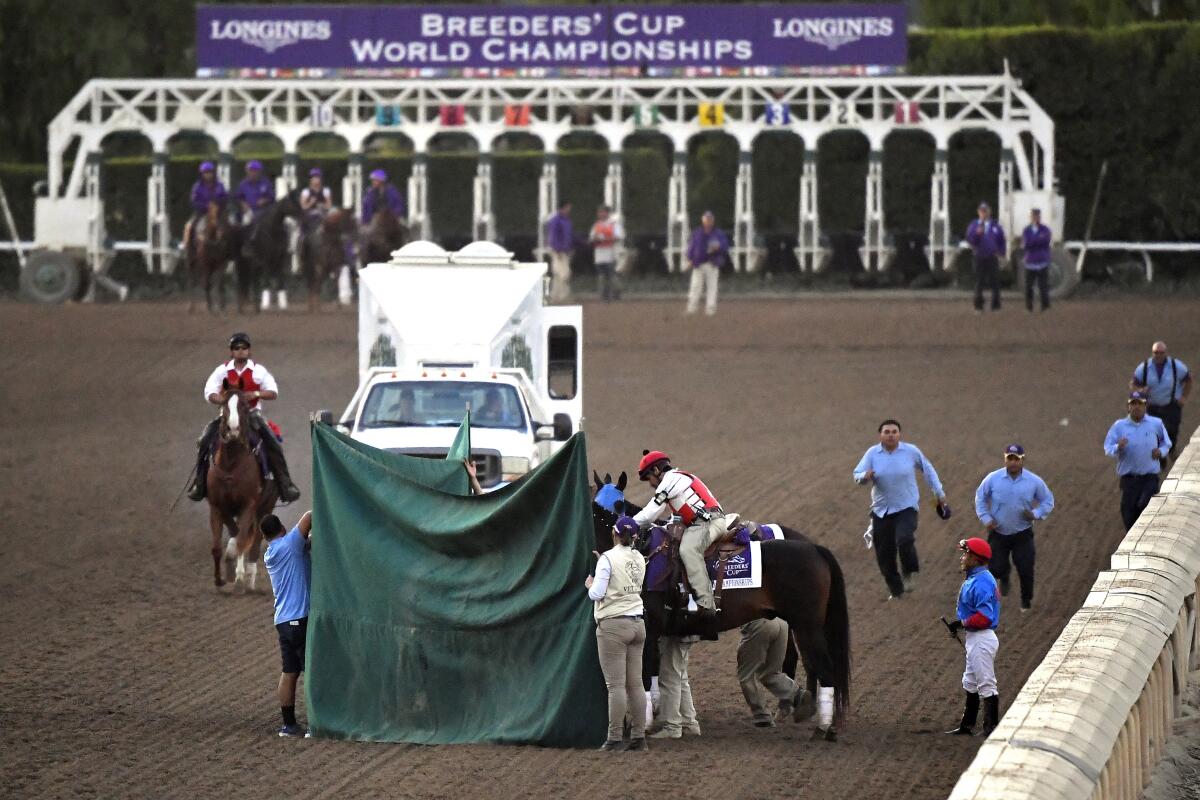Column: NBC teetered along precarious path in Breeders’ Cup coverage

- Share via
Until Saturday’s climactic race of the two-day Breeders’ Cup at Santa Anita, NBC had been quite thorough in providing proper context and measured tones in documenting what had occurred at the track in light of 36 thoroughbred deaths since December.
The reminders were precise and frequent for viewers tuning in and out of the extensive coverage, noting the abundance of precautions put into place to address the issues that continued amid the purple-clad pomp and circumstance of the sport’s richest day on live TV.
Reporter Kenny Rice repeatedly explained how mitigating factors directly led to several horses being scratched from races, a result of trainers and veterinarians erring to the side of caution.
“The awareness is quite keen here,” Rice said simply at one point.
But then the unnerving event actually happened.
Mongolian Groom injured his left hind leg while charging for the lead during the final furlong of the $6-million Breeders’ Cup Classic, followed by an interminable delay before news of it came to light. At that moment, one had to wonder how NBC’s challenge to function as a news-gathering organization as well as a broadcasting-rights partner could be compromised.
For two days, the best horses in the world traveled a collective distance of about 14 miles at Santa Anita. Then tragedy struck in the final race.
In trying to please two major stakeholders — the anxiety-ridden public and the sport it has beautifully covered for years — NBC likely didn’t satisfy either.
The most glaring fact critics can point to is that at least five minutes lapsed from the end of the race before viewers were apprised by NBC’s Ahmed Fareed that Mongolian Groom “pulled up.” It was premature to speculate anything further, but analyst Randy Moss immediately added, “It didn’t look like a minor injury.”
Viewers paying attention to how the race ended could have guessed as much.
As winner Vino Rosso crossed the finish line ahead of favorite McKinzie, NBC showed the traditional high grandstand camera shot. It then switched to a track-level, head-on shot of jockey Irad Ortiz Jr. celebrating. Clearly visible in the background was an equine ambulance arriving and attendants rushing across the dirt track.

NBC then did its customary post-race reaction interviews with Vino Rosso’s owners celebrating in the stands and Ortiz on his mount. Then came the injury acknowledgment.
NBC reporter Britney Eurton, whose father is a veteran thoroughbred trainer, interviewed on-call trackside veterinarian Alan Ruggles for a live update. More NBC discussion followed briefly — “with all the safeguards in place, it’s unfortunate,” Moss said — but then came a clunky commercial break.
Back on air, a high shot showed the equine ambulance leaving the track, with Mongolian Groom presumably inside. But as the 5 p.m.-to-6 p.m. window set aside for this race was rapidly closing, NBC had Fareed direct viewers to check www.nbcsports.com for further updates posted by columnist Tim Layden.
Then NBC moved onto the Winner’s Circle for the awards presentation.
A classic mixed message indeed.
Not that there is ever a convenient time for a thoroughbred breakdown, but viewers were left with an incomplete conclusion. Still, NBC could not have known that Breeders’ Cup officials would go nearly two hours after its coverage ended to announce Mongolian Groom had been euthanized.
In hindsight, what could NBC have done differently?
The previous 10-plus hours of Breeders’ Cup coverage had been on NBC’s cable sports channel, NBCSN, but that was already into an auto racing event. Maybe NBC points viewers to TVG, the Los Angeles-based horse racing channel doing parallel coverage the last two days.
Maybe NBC could have avoided appearing to have a disconnect by not posting on its Twitter feed a 14-second video celebrating Vino Rosso’s victory — with nothing mentioned of the Mongolian Groom injury.
Maybe NBC could have carved out even five more minutes — on the West Coast, it was a replay of the “NBC Nightly News” — and discussed one more isolated replay focused only on Mongolian Groom. The injury, as evidenced by screen shots of the NBC video, was hardly anything that could be deemed too gruesome.
An NBC spokesperson responded Sunday to a list of emailed questions:
“When trying to balance covering victory with the developing injury, we always take great care to avoid speculation. Once we were aware of the injury after the race, we reported on it, followed by comments from Jerry Bailey and Randy Moss, and then an on-camera interview with the trackside vet.
“We have covered difficult circumstances in the past, so unfortunately we have experience in this area. This year, in particular, we reported on any and every issue in the sport with information, interviews, essays and discussion in multiple shows and on NBCSports.com, from the Triple Crown prep races through the Breeders’ Cup, including a five-minute segment where we discussed the issues in the minutes leading up to the race on Saturday.”
There’s no question about NBC’s diligent prep work.
When Layden’s story posted hours later to summarize the day’s events, it came with a headline: “Racing’s turbulent year continues.”
By then, the former Sports Illustrated writer had already aptly tweeted out: “The perspective on Mongolian Groom’s injury is obvious, but worth stating: Only a two-day sample, but the Breeders’ Cup was approximately a furlong from completing its races without an injury. That furlong might define the event, and for a while, the sport.”
More to Read
Go beyond the scoreboard
Get the latest on L.A.'s teams in the daily Sports Report newsletter.
You may occasionally receive promotional content from the Los Angeles Times.











